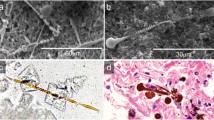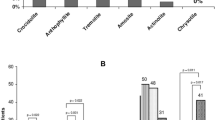Abstract
Asbestiform minerals, namely serpentine (chrysotile) and amphiboles (tremolite–actinolite) as well as others of fibrous habit (sepiolite) from Argentine deposits were characterised to assess their biological hazard. Materials currently used as asbestos substitutes were also assessed (glass fibre and ceramic fibre). Studies with laboratory animals were conducted. Sixty mice (30 females and 30 males), 8 weeks old, were used following the good practices in the care and handling of laboratory animals. They were split into six groups of ten mice each (5 females and 5 males), designated as control, tremolite, glass fibre, chrysotile, sepiolite and ceramic fibre, and were exposed by inhalation to these previously ground materials. The animals were examined throughout the experiments to see how they responded to the inhaled substances to establish the effects of inhalation at the time of exposure and once they had been killed. The respiratory tract (trachea, bronchi and lungs) of the animals exposed to the different materials was examined in tissue sections. Differences in the amount of connective tissue in the lungs and the presence of alveolar macrophages were observed in the animals exposed to tremolite, chrysotile and sepiolite, as compared to the control group. It was concluded that, of all the materials used, amphiboles caused greater damage and an incipient development of carcinogenesis. The other ones, especially chrysotile, produced connective tissue thickening.




Similar content being viewed by others
References
Albin M, Pooley FD, Strömberg U, Attewell R, Mitha R, Johansson L, Welinder H (1994) Retention patterns of asbestos fibres in lung tissue among asbestos cement workers. Occup Environ Med 51(3):205–211
Bernstein DM, Rogers R, Smith P (2005) The biopersistence of Canadian chrysotile asbestos following inhalation: final results through 1 year after cessation of exposure. Inhal Toxicol 17(1):1–14
Bernstein D, Dunnigan J, Hesterberg T, Brown R, Legaspi Velasco JA, Barrera R, Hoskins J, Gibbs A (2013) Health risk of chrysotile revisited. Crit Rev Toxicol 43(2):154–183
Camelo A, Dunmore R, Sleeman MA, Clarke DL (2014) The epithelium in idiopathic pulmonary fibrosis: breaking the barrier. Front Pharmacol. doi:10.3389/fphar.2013.00173
Casado A (1999) Cancer and asbestos. Vaccarezza Institute. University of Buenos Aires. Presented at the I Seminario de Actualización del Asbesto, Trabajo y Salud. Health Ministry, Argentina (In Spanish)
Davis JMG, Addison J, McIntosh C, Miller BG, Niven K (1991) Variations in the carcinogenicity of tremolite dust samples of differing morphology. Third wave of asbestos disease: exposure to asbestos. In: Landrigan PJ, Kazemi H (eds) Annals of the New York Academy of Sciences, vol 643, pp 473–490
Dodson RF, Atkinson MA, O’sullivan M (2005) Stability of ferruginous bodies in human lung tissue following death, embalmment, and burial. Inhal Toxicol 17(14):789–795
Duncan KE, Cook PM, Gavett ST, Dailey LA, Mahoney RK, Ghio AJ, Roggli VL, Devlin RB (2014) In vitro determinants of asbestos fiber toxicity: effect on the relative toxicity of Libby amphibole in primary human airway epithelial cells. Particle Fibre Toxicol 11:2
Galán E (1996) Properties and applications of palygorskite-sepiolite clays. Clay Miner 31:443–453
Goodwin A (1974) Proceedings of the symposium on talc, Washington. Bureau of Mines Information Circular, vol 8639
Guide for the Care and Use of Laboratory Animals (1996) Institute of Laboratory Animal Resources Commission on Life Sciences National Research Council. National Academy Press, Washington
International Centre for diffraction Data (ICDD) (1993) Mineral powder diffraction file. Databook, Park Lane. Swarthmore, Pennsylvania
Jones BF, Galán E (1988) Sepiolite and palygorskite. Hydrous phyllosilicates (Exclu-sive of Micas). In: Bailey SW (ed) Reviews in Mineralogy, Mineralogical Society of America, vol 19, Washington, DC, pp 632–674
Kang D, Myung MS, Kim YK, Kim JE (2013) Systematic review of the effects of asbestos exposure on the risk of cancer between children and adults. Ann Occup Environ Med 25:10
Leake BE, Woolley AR, Arps CE, Birch WD, Gilbert MC, Grice JD, Hawthorne FC, Kato A, Kisch HJ, Krivovichev VG, Linthout K, Laird J, Mandarino JA, Maresch WV, Nickel EH, Rock NMS, Schuhmacher JC, Smith DC, Stephenson N, Ungaretti L, Whittaker E, Youzhi G (1997) Nomenclature of amphiboles: report of the subcommittee on amphiboles of the International Mineralogical Association, commission on new minerals and mineral names. Can Mineral 35:219–246
Marín Martínez B, Clavera I (2005) Asbestosis. An Sist Sanit Navar 28(Supl. 1):37–44
Matos EL, Loria DI, Zengarini N (1997) Atlas of cancer mortality in Argentina between 1989 and 1992. Edición del Comité Argentino de Coordinación Programa Latino América Contra el Cáncer. Buenos Aires, Argentina, pp 10–30 (In Spanish)
Murray HM (1907) Report of the Departmental committee on compensation for industrial diseases. Minutes of evidence. CD 3946 Her Majesty’s Stationery Office, London, pp 127–128
Nishimura Y, Maeda M, Kumagai-Takei N, Lee S, Matsuzaki H, Wada Y, Nishiike-Wada T, Iguchi H, Otsuki T (2013) Altered functions of alveolar macrophages and NK cells involved in asbestos-related diseases. Environ Health Prev Med 18:198–204
OECD (2009) Guidance document on acute inhalation toxicity testing. Environmental health and safety monograph series on testing and assessment, vol 39. OECD, Paris. http://www.oecd.org/env/testguidelines
Pérez JE, Oresti GM, Melatini G, Bertón P, Ullua N, Gandini NA, Gigola G, Zwenger AO, Fermento ME (2006) Clinical histories and daily reports for research: tools for carcinogenesis studies in animal models. Oncología Clínica 11(1):1278–1284 (In Spanish)
Robinson BM (2012) Malignant pleural mesothelioma: an epidemiological perspective. Ann Cardiothorac Surg 1(4):491–496
Rodríguez EJ (2004) Asbestos banned in Argentina. Int J Occup Environ Health 10:202–208
Roggli VL, Vollmer RT (2008) Twenty-five years of fiber analysis: what have we learned. Hum Pathol 39:307–315
Ross M, Nolan RR, Langer AM, Cooper WC (1993) Health effects of mineral dusts other than asbestos. In: Guthrie GD, Mossman BT (eds) Health effects of mineral dusts, reviews in mineralogy, vol 28. Mineralogical Society of America, Washington, D.C., pp 361–407
Rowlands N, Gibbs GW, McDonald AD (1982) Asbestos fibres in the lungs of chrysotile miners and millers—a preliminary report. Ann Occup Hyg 26:411–415
Sánchez VC, Pietruska JR, Miselis NR, Hurt RH, Kane AB (2009) Biopersistence and potential adverse health impacts of fibrous nanomaterials: what have we learned from asbestos? Wiley Interdiscip Rev Nanomed Nanobiotechnol 1:511–529
Santarén J, Álvarez A (1994) Assessment of the health effects of mineral dusts. The sepiolite case. Ind Miner 1–12
Skinner HCW, Ross M, Frondel C (1988) Asbestos and other fibrous materials. Oxford University Press, UK
Valeyre D, Letourneaux M (1999) Asbestose. Rev Mal Respir 16:1294–1307
Van Oss CJ, Naim JO, Costanzo RM, Giese RE, Wu W Jr, Sorling AE (1999) Impact of different asbestos species and other mineral particles on pulmonary pathogenesis. Clays Clay Miner 47(6):697–707
Wicks FJ, Whittaker EJW (1975) A reappraisal of the structures of the serpentine minerals. Can Miner 13:227–243
Acknowledgments
The authors thank Ricardo Camina from the Department of Mathematic, the Departments of Geology and Biochemical Biology and Pharmacy of the Universidad Nacional del Sur, the Comisión de Investigaciones Científicas de la Provincia de Buenos Aires and CONICET. This work was funded by a FONCyT project.
Author information
Authors and Affiliations
Corresponding author
Rights and permissions
About this article
Cite this article
Lescano, L., Gandini, N.A., Marfil, S.A. et al. Biological effects of argentine asbestos: mineralogical and morphological characterisation. Environ Earth Sci 73, 3433–3444 (2015). https://doi.org/10.1007/s12665-014-3638-2
Received:
Accepted:
Published:
Issue Date:
DOI: https://doi.org/10.1007/s12665-014-3638-2




